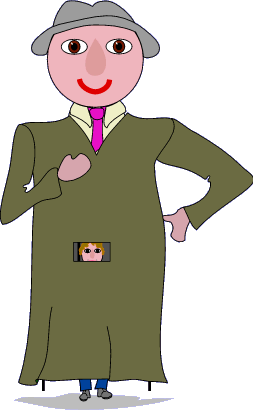 The giant you meet walking down the street is not all he seems. For a start, no giant is solid. A solid giant would weigh far too much for the poor porter to carry. What you see on the outside is very nearly all there is to see.
The giant you meet walking down the street is not all he seems. For a start, no giant is solid. A solid giant would weigh far too much for the poor porter to carry. What you see on the outside is very nearly all there is to see.

These pictures do not represent any giant in particular. Every giant is different. Most giants will have some or all of these features. The giant in the pictures is, technically speaking, a type of Standing Frame giant. There are other ways of building a frame. No matter what sort of frame is used the problems of weight, balance and so on, are the same.
 The giant you meet walking down the street is not all he seems. For a start, no giant is solid. A solid giant would weigh far too much for the poor porter to carry. What you see on the outside is very nearly all there is to see.
The giant you meet walking down the street is not all he seems. For a start, no giant is solid. A solid giant would weigh far too much for the poor porter to carry. What you see on the outside is very nearly all there is to see.
A 'dancing' or 'pageant' giant is really a frame covered with clothes. The whole giant is carried ( usually) by one person called the porter. In most cases the porter has to be trained. It's not just that giants are heavy, they also have to be balanced. If there's a wind they have to be balanced so that they are not blown over. It can be very hard work.
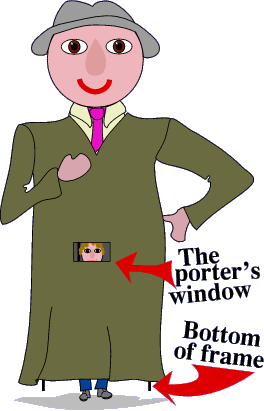
Look carefully. You will see the bottom of the giant's frame sticking out below his clothes. When he is standing without a porter he rests on these little legs. Probably they are the ends of poles that go all the way to the top of the giant.
Now notice the porter's feet, they are exactly under the giant's head (unless there's a wind). That's because he has to balance the weight of the giant above his head. There's no way he can let the giant lean safely. If the giant were tilted only a little bit, it would probably topple over.
Of course the porter has to be able to see where he's going. To let him see out there is a little window in the front of the giant, called the porter's window. The porter hasn't got a very good view, and there are always other people around to help him find his way without bumping into things. these people are called guides and minders.
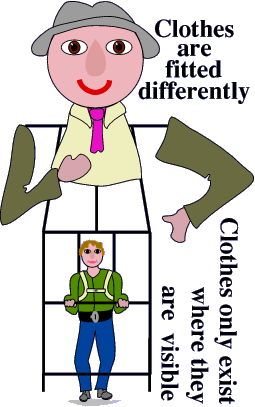
Giants don't bend where people do. So they don't wear their clothes in quite the same way. Usually the clothes come apart in quite different places to people's clothing. The parts of a giant's clothes that are hidden under other garments aren't even there. Cloth really is very heavy when you have to have enough of it to cover a giant and you only make the bits that show.
For the same reason the only bits of the giant that are made properly are the bits that show. Everything else is really just a lightweight framework. As you can guess, the design of a giant's frame is really a problem for an engineer. It's less obvious that the design of a giant's clothes is really a task for an upholsterer.
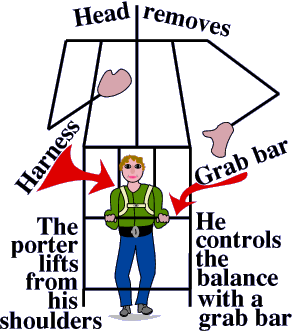
Some giants are made in one huge piece, such giants are very hard to transport and so they tend not to travel far from home. They are not easy to store either.
Most giants are made to come apart in some way, so that the bits can be put into a van, transported to the next display, and rebuilt there.
It's important that a giant's frame is very stiff. A giant that wobbles is very hard to carry. This doesn't mean they have to be made extra strong and heavy, strong is not the same as stiff. An ideal giant is light and stiff. If a giant is made to come apart it's important that the connections are not sloppy. They have to be very firm so that the giant remains as stiff as possible.
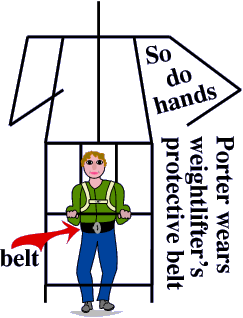
Usually the porter lifts the giant with his shoulders. He gets under the giant with his knees bent, carefully fits himself into the carrying position, and stands up. NOW he's carrying the giant. There will be harness straps or pads to take the weight. Sometimes the weight of the giant is partly resting on the porter's head. There will be some sort of grab bar for the porter to hold, he uses this to control the balance of the giant. Sometimes he just holds the upright poles of the frame. Often the porter has a waist strap so that he can stop the giant tilting just by standing up a little straighter himself.
It's very important that the porter has some sort of protection for his back. It's easy for a porter to hurt himself if there's a sudden gust of wind when he's not ready for it. Some giants have a firm back-pad that straps to the porter and keeps his spine straight. If there's no protective pad, the porter wears a special belt, often it's a weight-lifter's belt. Another sort of belt is a cummerbund. It's a very long, wide, strip of cloth that's wound very tightly round and round the porter's waist to keep his back straight.
This page is an extract from the BIGG member's handbook.